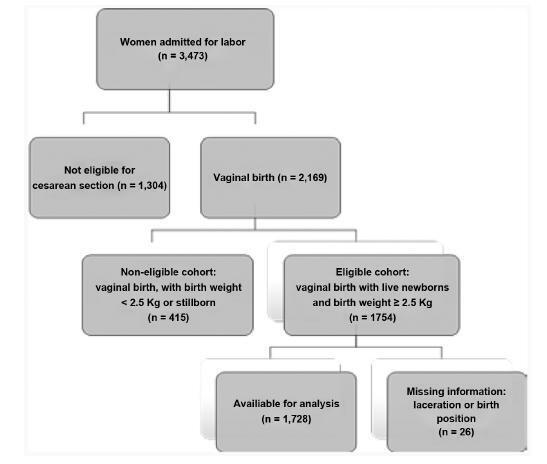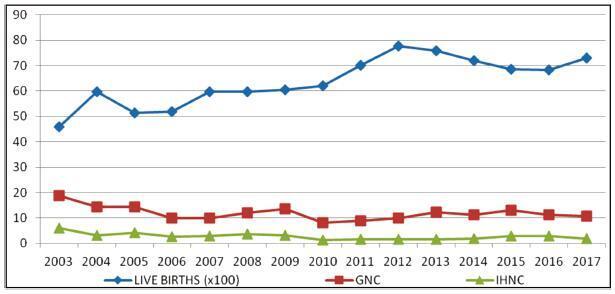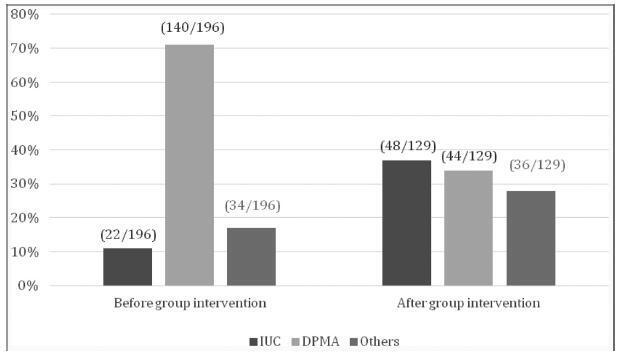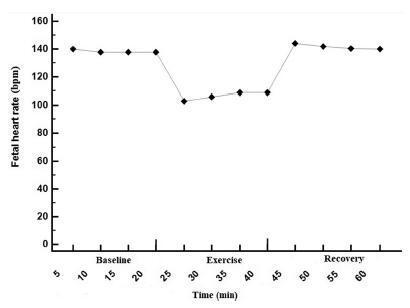-
Original Article12-20-2019
Knowledge, Attitude and Practice of Brazilian Obstetricians Regarding Episiotomy
Revista Brasileira de Ginecologia e Obstetrícia. 2019;41(11):636-646
Abstract
Original ArticleKnowledge, Attitude and Practice of Brazilian Obstetricians Regarding Episiotomy
Revista Brasileira de Ginecologia e Obstetrícia. 2019;41(11):636-646
Views153Abstract
Objective
To determine the prevalence of episiotomy and the factors associated with the knowledge, attitude and practice (KAP) of Brazilian obstetricians in relation to this procedure.
Methods
A KAP survey was conducted with obstetricians working in Brazil. An electronic form containing structured questions previously evaluated using the Delphi method was created in Google Docs and sent by e-mail. A multivariate logistic regression was performed to determine the principal factors associated with adequate KAP. For each dependent variable (knowledge, attitude and practice) coded as adequate (1 = yes; 0 = no), a multiple logistic regression model was developed. Binary codes (1 = yes and 0 = no) were assigned to every independent or predictor variables. Prevalence ratios (PRs) and their respective 95% confidence intervals (95%CIs) were calculated as measures of relative risk, at a significance level of 5%.
Results
Out of the 13 thousand physicians contacted, 1,163 replied, and 50 respondents were excluded. The mean episiotomy rate reported was of 42%. Knowledge was determined as adequate in 44.5% of the cases, attitude, in 10.9%, and practice, in 26.8% of the cases.
Conclusion
Most respondents had inadequate knowledge, attitudes and practices regarding episiotomy. Although some factors such as age, teaching, working in the public sector and attending congresses improved knowledge, attitude and practice, we must recognize that episiotomy rates remain well above what would be considered ideal. Adequate knowledge is more prevalent than adequate attitude or practice, indicating that improving knowledge is crucial but insufficient to change the outlook of episiotomies in Brazil.
Key-words attitudes in healthDeliveryEpisiotomyhealth knowledgeObstetricsPerineumpractices in healthSee more -
Original Article11-07-2019
Do We Know How to Avoid OASIs in Non-Supine Birth Positions? A Retrospective Cohort Analysis
Revista Brasileira de Ginecologia e Obstetrícia. 2019;41(10):581-587
Abstract
Original ArticleDo We Know How to Avoid OASIs in Non-Supine Birth Positions? A Retrospective Cohort Analysis
Revista Brasileira de Ginecologia e Obstetrícia. 2019;41(10):581-587
Views183See moreAbstract
Objective
To evaluate the association between the upright and supine maternal positions for birth and the incidence of obstetric anal sphincter injuries (OASIs).
Methods
Retrospective cohort study analyzed the data of 1,728 pregnant women who vaginally delivered live single cephalic newborns with a birth weight of 2,500 g. Multiple regression analyses were used to investigate the effect of the supine and upright positions on the incidence of OASIs after adjusting for risk factors and obstetric interventions.
Results
In total, 239 (13.8%) births occurred in upright positions, and 1,489 (86.2%) in supine positions. Grade-III lacerations occurred in 43 (2.5%) patients, and grade-IV lacerations occurred in 3 (0.2%) women. Supine positions had a significant protective effect against severe lacerations, odds ratio [95% confidence interval]: 0,47 [0.22- 0.99], adjusted for the use of forceps 4.80 [2.15-10.70], nulliparity 2.86 [1.44-5.69], and birth weight 3.30 [1.56-7.00]. Anesthesia (p<0.070), oxytocin augmentation (p<0.228), shoulder dystocia (p<0.670), and episiotomy (p<0.559) were not associated with the incidence of severe lacerations.
Conclusion
Upright birth positions were not associated with a lower rate of perineal tears. The interpretation of the findings regarding these positions raised doubts about perineal protection that are still unanswered.

-
Original Article11-07-2019
Contribution of Ultra-processed Food to the Daily Food Intake of HIV-positive and HIV-Negative Women during Pregnancy
Revista Brasileira de Ginecologia e Obstetrícia. 2019;41(10):588-596
Abstract
Original ArticleContribution of Ultra-processed Food to the Daily Food Intake of HIV-positive and HIV-Negative Women during Pregnancy
Revista Brasileira de Ginecologia e Obstetrícia. 2019;41(10):588-596
Views226See moreAbstract
Objective
To assess the daily dietary intake and energy contribution of ultraprocessed foods among women who are positive and negative for the human immunodeficiency virus (HIV) during pregnancy.
Methods
This case-control study included 77 HIV-positive and 79 HIV-negative puerperal women between 2015 and 2016. The socioeconomic and maternal demographic data were assessed, and a food frequency questionnaire (FFQ) adapted for pregnant women was applied. The Fisher exact test and the Mann-Whitney test were applied to detect differences between the groups. Linear regression was used to assess the associations between the intake of ultra-processed food and energy, macro- and micronutrients, with values of p < 0.05 considered significant.
Results
The HIV-positive group was older (p< 0.001) and had lower income (p= 0.016) and level of schooling (p< 0.001) than the HIV-negative group. Both groups presented similar average food intake: 4,082.99 Kcal/day and 4,369.24 Kcal/day for the HIV-positive and HIV-negative women respectively (p= 0.258).The HIV-positive group consumed less protein (p= 0.048), carbohydrates (p= 0.028) and calcium(p= 0.001), andmore total fats (p= 0.003). Ultra-processed foods accounted for 39.80% and 40.10% of the HIV-positive and HIV-negative groups’ caloric intake respectively (p= 0.893). The intake of these foods was associated with a higher consumption of carbohydrates (p < 0.001), trans fat (p= 0.013) and sodium (p< 0.001), as well as lower protein (p < 0.001) and fiber intake (p= 0.022).
Conclusion
These findings demonstrate that the energy consumption and ultraprocessed food intake were similar in both groups, which reinforces the trend toward a high intake of ultra-processed food in the general population. The intake of ultraprocessed food was positively associated with the consumption of carbohydrates, trans fat and sodium, and negatively associated with the consumption of protein and fiber.
-
Original Article11-07-2019
Trends Associated with Stillbirth in a Maternity Hospital School in the North Zone of São Paulo: A Cross-Sectional Study
Revista Brasileira de Ginecologia e Obstetrícia. 2019;41(10):597-606
Abstract
Original ArticleTrends Associated with Stillbirth in a Maternity Hospital School in the North Zone of São Paulo: A Cross-Sectional Study
Revista Brasileira de Ginecologia e Obstetrícia. 2019;41(10):597-606
Views177See moreAbstract
Objective
To evaluate conditions associated with stillbirth (SB), and possible trends related with it, in a maternity hospital school in the North zone of São Paulo.
Methods
An observational, cross-sectional study conducted at the Hospital Maternidade- escola de Vila Nova Cachoeirinha with 1,139 SBs in the period of 2003 to 2017. Cases of intermediate SB (ISB) (weight between 500 and 999 g) and late SB (LSB) (weight ≥ 1,000 g) were compared. We evaluated clinical data, laboratory tests, and fetal and placental studies. Data were stored in Windows Excel (Microsoft Corp., Redmond, WA, USA) worksheets, according to which graphs and tables were constructed. We used the statistical software SPSS for Windows version 18.0 (SPSS In., Chicago, IL, USA), estimating the prevalence ratio (PR) and odds ratio (OR), considering the 95% confidence interval (95% CI).
Results
The general SB rate was 11.9%, and the in-hospital SB rate was 2.8%. Pregnant women younger than 16 years of age were more likely to have ISB (OR 0.32, 0.15- 0.76), while patients older than 40 years old had a higher chance of LSB (PR 0.85, 0.72- 0.99). A total of 25.7% of the general population did not have prenatal care, and 77.1% of the cases presented fetal death at admission. The cases of ISB had a statistically significant association with home birth (OR 0.61, 0.46-0.80). Cesarean section was performed in 16.1% of the subjects, and misoprostol was the most used method for induction. Necropsy and placental study of the fetuses were performed, respectively, in 94.2% and 97.3% of the cases. Associated causes were not identified in 22.1% of the cases, and the main causes identified were amniotic sac infections (27.9%), fetal malformations (12.5%), placental abruption (11.2%), hypertensive syndromes (8.5%), and maternal syphilis (3.9%), the latter with an increasing trend.
Conclusion
Among the factors associated to SB were: hypertensive syndromes, amniotic sac infections, fetal malformations, placental abruption and syphilis. There was a growing trend in the number of cases of syphilis, which translates an alert. Diagnostic limitations justify indeterminate causes.

-
Original Article11-07-2019
Empowering Adolescent Mothers in the Choice of Contraceptive Methods at the Postpartum Period: Avoiding a Subsequent Pregnancy
Revista Brasileira de Ginecologia e Obstetrícia. 2019;41(10):607-612
Abstract
Original ArticleEmpowering Adolescent Mothers in the Choice of Contraceptive Methods at the Postpartum Period: Avoiding a Subsequent Pregnancy
Revista Brasileira de Ginecologia e Obstetrícia. 2019;41(10):607-612
Views182Abstract
Objective
Almost 80% of adolescent pregnancies are unplanned, and between 28 and 63% of adolescent mothers had a repeated pregnancy within 18 months. Among girls with repeated pregnancies, two-thirds reported that the pregnancy was unplanned. We aim to assess contraceptive use by adolescent mothers with increasing choice for long-acting reversible contraception (LARC) methods in postpartum consultation after a semistructured group intervention involving adolescent mothers.
Methods
Retrospective observational study conducted at the Universidade Estadual de Campinas, Campinas, state of São Paulo, Brazil, involving new antenatal and postpartum education groups for adolescents. At postpartum consultations, the adolescents chose their contraceptive. The datawas compared with previous series followed in a period before the implementation of the education group - a historical control group.
Results
We included 129 adolescent after childbirth from January 1st, 2015 through July 31st, 2017. Out of this total, 63% had ever used contraceptive methods before pregnancy, and the most frequent method was combined oral contraceptives (33%) followed by condoms (21%). At the first postpartum consultation, the most common contraceptive chosen was intrauterine contraception (IUC) (37.2%) and depot-medroxyprogesterone acetate (DMPA) (34.1%).When comparing the rates before and after the education interventions, there was a 3-fold increase in the use of IUCs.
Conclusion
Antenatal and postpartum education have shown a significant increase in the choice for LARC methods among adolescent mothers, with very high acceptability after a period using the method. The educational groups performed during the antenatal care and beyond the gestational period are easy to be applied worldwide with low dependence on funding.
Key-words Adolescentantenatal educationContraceptionlong-acting reversible contraceptionPostpartum periodSee more
-
Original Article11-07-2019
Attitudes and Personal Attributes Regarding Patient Receptivity towards the Participation of Medical Students in Gynecological Consultations: A Cross-Sectional Study
Revista Brasileira de Ginecologia e Obstetrícia. 2019;41(10):613-620
Abstract
Original ArticleAttitudes and Personal Attributes Regarding Patient Receptivity towards the Participation of Medical Students in Gynecological Consultations: A Cross-Sectional Study
Revista Brasileira de Ginecologia e Obstetrícia. 2019;41(10):613-620
Views181See moreAbstract
Objective
To evaluate the association between the acceptance on the part of the patients and their reasons to consent to or refuse medical student attendance during gynecological outpatient care, considering the participants’ demographic characteristics, consultation experience, and gender bias or lack thereof.
Methods
Face-to-face interviews with patients waiting for gynecological consultations that had been scheduled in advance at Hospital Universitário de Brasília. Contingency analyses were used to determine the levels of association among the patient variables. The accepted significance level was values of p<0.05.
Results
We interviewed 469 patients. The comfort level with the presence of a student was strongly related to the number of students present during the consultation (Cramér V=0.671). The inclination to grant consent (a series of reasons to consent to or refuse student attendance) was significantly related (p<0.001) to the overall receptivity to student participation (ρ=0.482), the positive appraisal of student-doctor demeanor in previous consultations (ρ=0.253, N=408), and to greater levels of schooling (ρ=0.158). The patients’ receptivity was significantly related (p<0.001) to the lack of bias regarding the gender of the physician (CramérV=0.388), previous experience with students (Cramér V=0.235) and awareness of the fact that they would be present (Cramér V=0.217), older age (ρ=0.136, p=0.003), and multiparity (ρ=0.102, p=0.027).
Conclusion
Greater receptivity to student participation related significantly to five conditions in decreasing order of strength of association: lack of bias regarding the gender of the Ob-Gyn, previous experience with student involvement, awareness of the presence of students, older age, and multiparity. We also found that a more positive inclination to consent to student attendance correlated positively with a greater receptivity to student participation and to a suitable student-doctor demeanor.
-
Original Article09-30-2019
Progesterone’s Serum Level and a New Ultrasonographic Parameter in the First Trimester Pregnancy – Prognostic Factors for Embryonic Demise
Revista Brasileira de Ginecologia e Obstetrícia. 2019;41(9):525-530
Abstract
Original ArticleProgesterone’s Serum Level and a New Ultrasonographic Parameter in the First Trimester Pregnancy – Prognostic Factors for Embryonic Demise
Revista Brasileira de Ginecologia e Obstetrícia. 2019;41(9):525-530
Views195See moreAbstract
Objective
The etiology of embryonic demise is multifactorial, with chromosomal abnormalities being the most common (40%). The purpose of the present study is to evaluate the correlation between a serum biomarker, progesterone, and an ultrasonographic parameter, the distance between yolk sac and embryo (DYSE) in assessing the prognosis of pregnancy outcome in the 1st trimester.
Methods
The present study is a prospective case-control analysis that includes 2 groups of patients: 81 patients with first-trimester normal evolutive pregnancy and 89 patients with embryonic demise, all of the patients having between 6 and 11 weeks of amenorrhea. Endovaginal ultrasonographic exploration was performed to evaluate the distance between the lower pole of the embryo and the yolk sac. From each subject enrolled in the study, 20ml of blood was collected for progesterone serum level measurement.
Results
Regarding the DYSE in the case group, lower values were observed compared with the control group, the difference being statistically significant. In the statistical analysis of serum progesterone values, statistically significant differences were observed between the 2 groups (p<0.05).
Conclusion
The DYSE has a high positive predictive value in identifying pregnancies with potentially reserved outcome, with the present study demonstrating that a DYSE<3mm causes an unfavorable evolution of the pregnancy. Low serum levels of progesterone are associated with an increased rate of nonviable embryos. The correlation between these two parameters increases the effectiveness of screening methods in prenatal monitoring and improves the diagnostic methods for the firsttrimester pregnancies whose outcome potential can be reserved.
-
Original Article09-30-2019
Is Moderate Intensity Exercise during Pregnancy Safe for the Fetus? An Open Clinical Trial
Revista Brasileira de Ginecologia e Obstetrícia. 2019;41(9):531-538
Abstract
Original ArticleIs Moderate Intensity Exercise during Pregnancy Safe for the Fetus? An Open Clinical Trial
Revista Brasileira de Ginecologia e Obstetrícia. 2019;41(9):531-538
Views210See moreAbstract
Objective
To determine the effect of treadmill walking on maternal heart rate (MHR) and cardiotocographic parameters (basal fetal heart rate [FHR], active fetal movements [AFM], number of accelerations and decelerations, and short-term variation [STV] and long-term variation [LTV] of fetal heart rate) in pregnant women at 36 weeks.
Methods
A nonrandomized, open clinical trial involving 88 healthy pregnant women submitted to moderate intensity walking and computed cardiotocography in 3 20- minute periods (resting, treadmill walking, and postexercise recovery).
Results
The mean FHR decreased during walking (resting: 137 bpm; treadmill: 98 bpm; recovery: 140 bpm; p<0.001), with bradycardia occurring in 56% of the fetuses in the first 10minutes of exercise, and in 47% after 20minutes. Bradycardia was not detected in the other phases. The mean STV and HV were 7.9, 17.0, and 8.0 milliseconds (p<0.001) and 7.6, 10.8 and 7.6 bpm (p=0.002) in the resting, walking and recovery phases, respectively. Themean number of fetalmovements in 1 hour was 29.9, 22.2 and 45.5, respectively, in the 3 periods (p<0.001). In overweight/obese women, the mean FHR was lower (p=0.02). Following the logistic regression analysis, two variables remained significantly associated with bradycardia: maternal fitness in the 28th week of pregnancy (protective effect) and maternal weight (increased risk).
Conclusion
In healthy fetuses, physical exercise proved to be safe, since, although FHR and AFM decreased during treadmill walking, an increase in SVT and LTV was observed.



